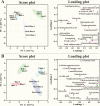Effect of LED Lights on Secondary Metabolites and Antioxidant Activities in Red Pakchoi Baby Leaves
- PMID: 38854528
- PMCID: PMC11154946
- DOI: 10.1021/acsomega.3c10261
Effect of LED Lights on Secondary Metabolites and Antioxidant Activities in Red Pakchoi Baby Leaves
Abstract
Pakchoi (Brassica rapa subsp. chinensis) is one of the most widely consumed vegetables in Asian countries, and it is high in secondary metabolites. The availability, quantity, and quality of light play a critical role in the growth and development of plants. In this study, we investigated the effect of LEDs (light-emitting diodes; white, blue, red, and red + blue) on anthocyanin, glucosinolates, and phenolic levels in red pakchoi baby leaves. On the 24th day after sowing (DAS), red baby pakchoi leaves were harvested, and shoot length, root length, and fresh weight were measured. Among the different LED treatments, there was no significant difference in shoot length, whereas the highest root length was achieved in the red + blue LED treatment (23.8 cm). The fresh weight also showed a significant difference among the different LED treatments. In total, 12 phenolic and 7 glucosinolate individual compounds were identified using high-performance liquid chromatography (HPLC) analysis. The highest total glucosinolate (2937 μg/g dry wt) and phenolic (1589 μg/g dry wt) contents were achieved in baby leaves exposed to red + blue light. Similarly, the highest contents of total anthocyanins (1726 μg/g dry wt), flavonoids (4920 μg/g dry wt), and phenolics (5900 μg/g dry wt) were achieved in the red + blue treatment. Plants exposed to red + blue LED light showed the highest accumulation of anthocyanin, glucosinolates, and phenolic compounds. For antioxidant activity, DPPH (2,2-diphenyl-1-picrylhydrazylradical) free radical scavenging, ABTS (2,2-azinobis (3-ethylbenzothiazoline)-6-sulfonic acid) radical scavenging, and reducing power assays were performed, and the antioxidant activity of red pakchoi baby leaves grown under red + blue LED light was found to be the best. The metabolic profiling of the identified metabolites revealed distinct separation based on the secondary metabolites. This research will be helpful for farmers to choose the best LED light combination to increase the secondary metabolic content in pakchoi plants.
© 2024 The Authors. Published by American Chemical Society.
Conflict of interest statement
The authors declare no competing financial interest.
Figures






References
-
- Yeo H. J.; Baek S.-A.; Sathasivam R.; Kim J. K.; Park S. U. Metabolomic analysis reveals the interaction of primary and secondary metabolism in white, pale green, and green pak choi (Brassica rapa subsp. chinensis). Appl. Biol. Chem. 2021, 64 (1), 310.1186/s13765-020-00574-2. - DOI
-
- Tan W. K.; Goenadie V.; Lee H. W.; Liang X.; Loh C. S.; Ong C. N.; Tan H. T. W. Growth and glucosinolate profiles of a common Asian green leafy vegetable, Brassica rapa subsp. chinensis var. parachinensis (choy sum), under LED lighting. Sci. Hortic. 2020, 261, 10892210.1016/j.scienta.2019.108922. - DOI
LinkOut - more resources
Full Text Sources
